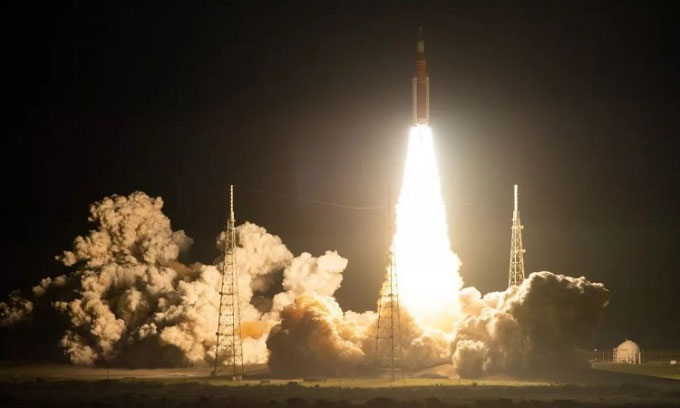The Orion spacecraft will fly close to the Moon’s surface twice before igniting its engines to return to Earth in mid-December, concluding the Artemis 1 mission.
The Artemis mission launched at 1:47 PM on November 16, Hanoi time, from Launch Pad 39B at NASA’s Kennedy Space Center, marking the first launch of the massive Space Launch System (SLS) rocket and initiating a 25-day journey to the Moon and back for the uncrewed Orion spacecraft.

The Artemis 1 mission launches from Kennedy Space Center in Florida on November 16. (Photo: NASA/Joel Kowsky).
The Orion spacecraft will spend the next six days traveling toward the Moon. On November 21, Orion will fly past the Moon at its closest approach, approximately 100 km from the surface. This maneuver will utilize the Moon’s gravitational pull to propel Orion further into space. The service module will then perform a second burn on November 25 to place the spacecraft into a distant retrograde orbit (DRO). There, the spacecraft will spend a week at an altitude of about 61,000 km above the Moon’s surface. On November 28, Orion will break the Apollo 13 record for the farthest distance traveled by a crew-capable vehicle from Earth, reaching about 483,000 km.
While in DRO, a series of active and passive sensors on board Orion will measure radiation and other flight conditions, allowing researchers to better understand the environment astronauts will experience during crewed missions. Although Artemis 1 is an uncrewed mission, Orion still has passengers in the form of mannequins.
Secured in the commander’s seat of the spacecraft is a mannequin named Moonikin Campos from NASA, equipped with internal radiation sensors. The sensors in the seat will record gravitational forces and vibrations throughout the flight. Accompanying Campos are two mannequins, Helga and Zohar, which have only upper bodies without arms, containing over 34 active radiation dose meters and 6,000 passive radiation dose meters to study the effectiveness of the specialized AstroRad radiation protection suit.
Helga and Zohar are constructed from materials that simulate human bone and tissue. Their bodies include several anatomical components related to female anatomy to mimic ovaries and breast tissue, which are sensitive to radiation. These two mannequins are part of the Matroshka AstroRad Radiation Experiment (MARE), where Zohar wears the AstroRad suit while Helga serves as a control. When the mannequins return to Earth, researchers will compare their radiation exposure levels.
If effective, the AstroRad suit will allow astronauts to conduct missions around the spacecraft. Without the protection of Earth’s magnetic field in low Earth orbit, areas farther from the planet are more susceptible to radiation, increasing the risk of radiation exposure for astronauts.
On December 1, Orion’s service module will perform a burn to leave DRO, bringing the spacecraft close to the Moon four days later. Subsequently, the service module will execute a final burn to set Orion on its six-day journey back to Earth.
On December 11, Orion will plunge through Earth’s atmosphere at a speed of 40,000 km/h, a significant test for the spacecraft and its heat shield as it endures temperatures reaching 2,750 degrees Celsius. Orion will then land via parachute in the Pacific Ocean, concluding the Artemis 1 mission.
If the Artemis 1 mission proceeds smoothly, Artemis 2 will send astronauts on a lunar flyby in 2024, and Artemis 3 will carry a crew to land at the Moon’s south pole the following year. From there, NASA will continue to build a sustainable base on and around the Moon, which is the primary goal of the Artemis program.


















































